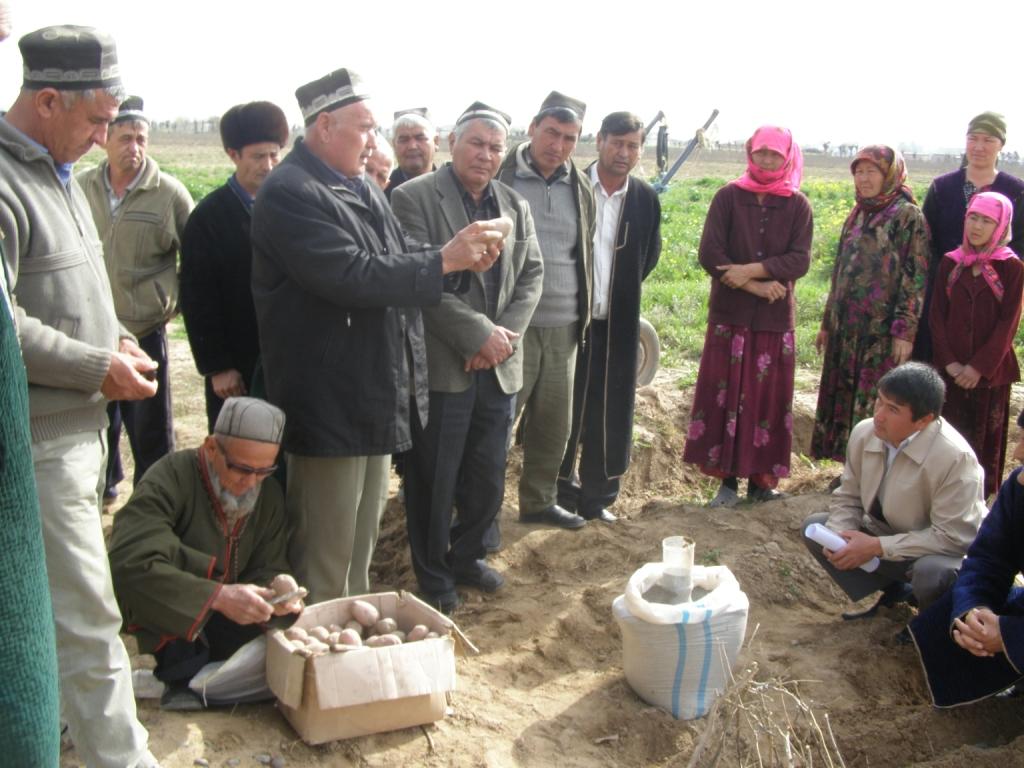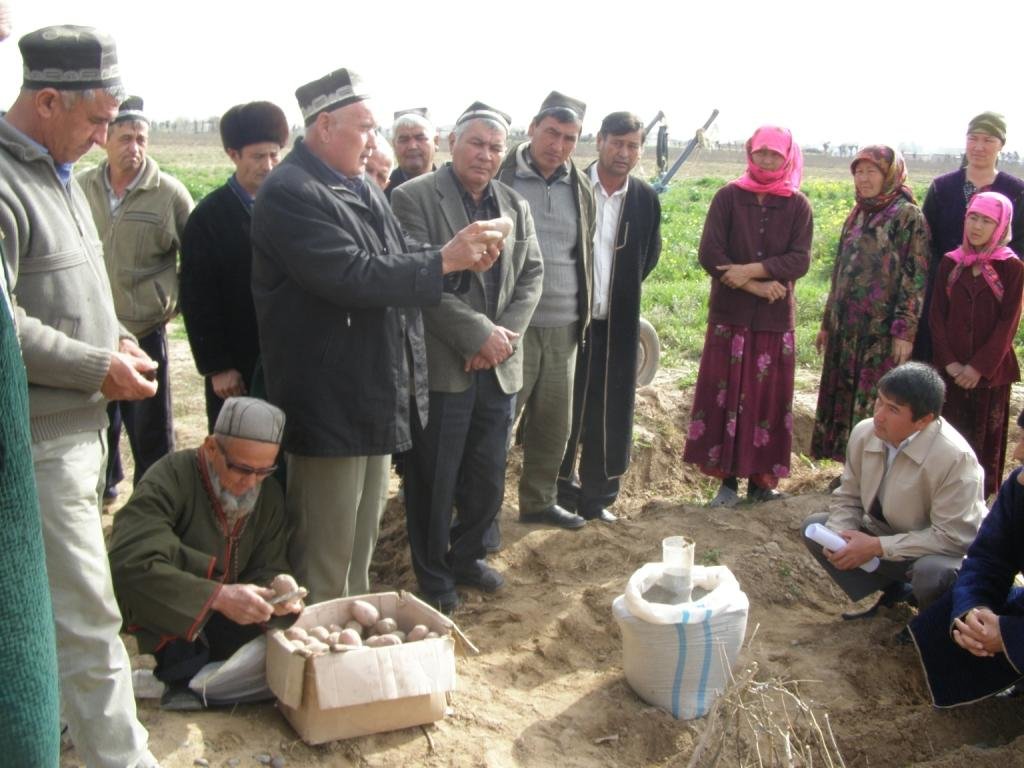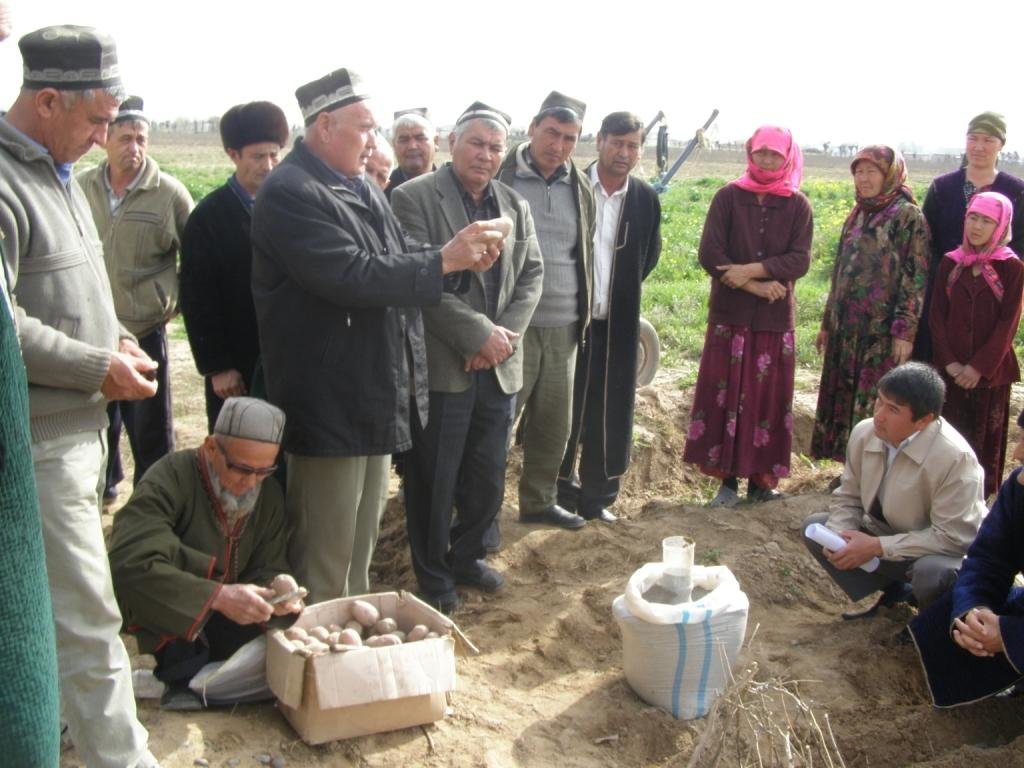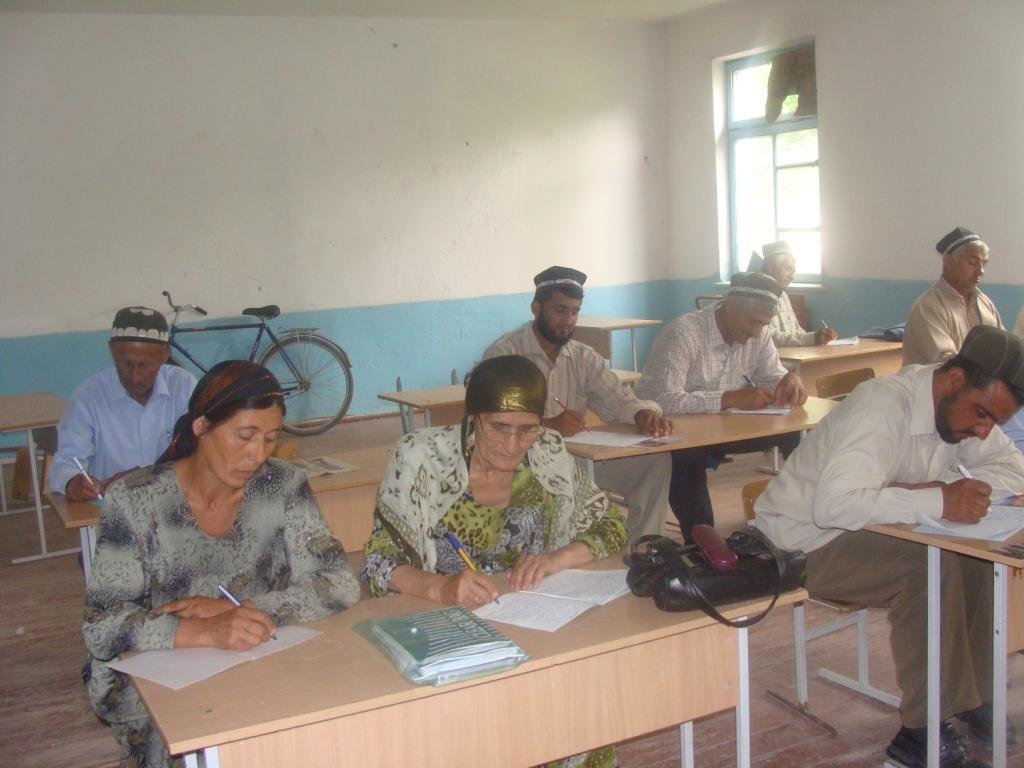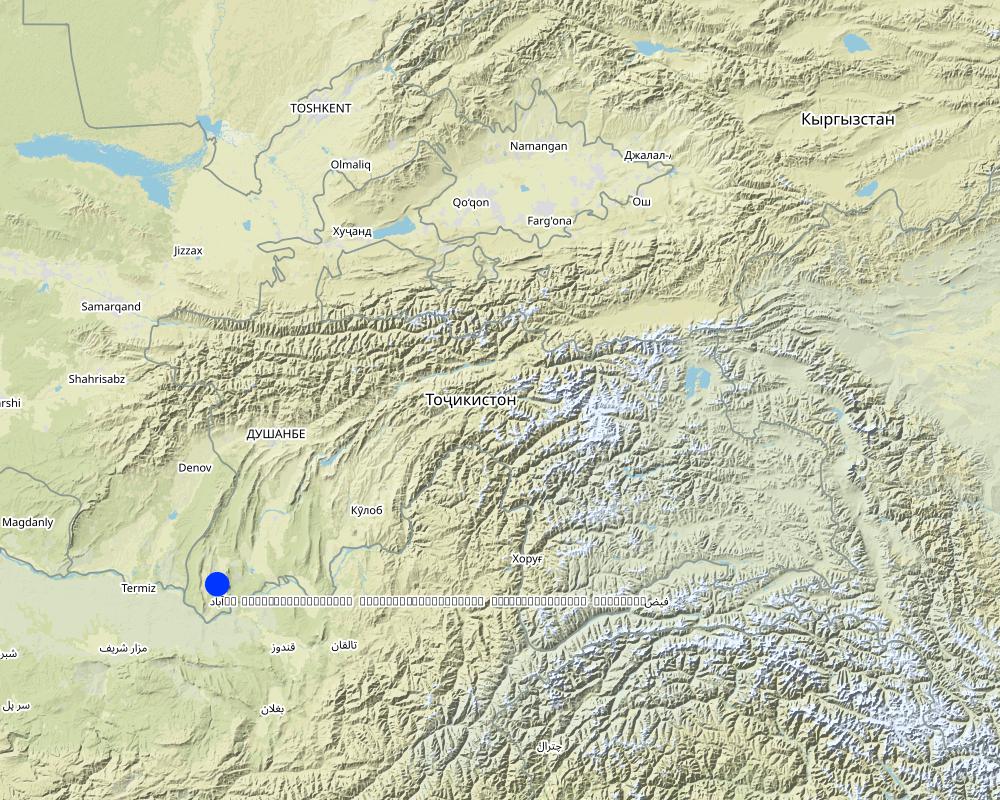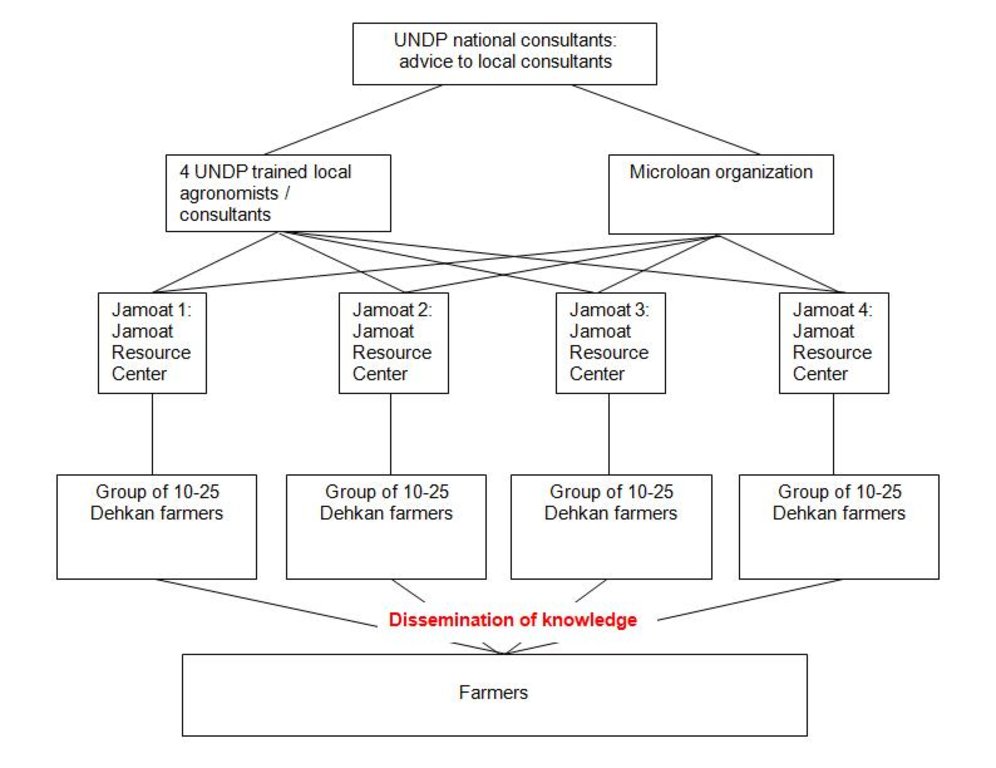Central Asian Countries Initiative for Sustainable Land Management (CACILM) [Tayikistán]
- Creación:
- Actualización:
- Compilador: Firdavs Faizulloev
- Editor: –
- Revisores: David Streiff, Alexandra Gavilano, Joana Eichenberger
Фермерские полевые школы
approaches_2439 - Tayikistán
- Resumen completo en PDF
- Resumen completo en PDF para imprimir
- Resumen completo en el navegador
- Resumen completo (sin formato)
- Central Asian Countries Initiative for Sustainable Land Management (CACILM): 2 de noviembre de 2021 (public)
- Central Asian Countries Initiative for Sustainable Land Management (CACILM): 8 de agosto de 2017 (inactive)
- Central Asian Countries Initiative for Sustainable Land Management (CACILM): 6 de julio de 2017 (inactive)
- Фермерские полевые школы: 6 de julio de 2017 (inactive)
Visualizar secciones
Expandir todo Colapsar todos1. Información general
1.2 Detalles de contacto de las personas de referencia e instituciones involucradas en la evaluación y la documentación del Enfoque
Especialista MST:
Especialista MST:
Especialista MST:
Urakov Buran
UNDP, Farmers Field School Consultant
Tayikistán
Nombre del proyecto que facilitó la documentación/ evaluación del Enfoque (si fuera relevante)
Central Asian Countries Initiative for Land Management (CACILM I)Nombre del proyecto que facilitó la documentación/ evaluación del Enfoque (si fuera relevante)
Pilot Program for Climate Resilience, Tajikistan (WB / PPCR)Nombre de la(s) institución(es) que facilitaron la documentación/ evaluación del Enfoque si fuera relevante)
United Nations Development Program (United Nations Development Program) - TayikistánNombre de la(s) institución(es) que facilitaron la documentación/ evaluación del Enfoque si fuera relevante)
CDE Centre for Development and Environment (CDE Centre for Development and Environment) - Suiza1.3 Condiciones referidas al uso de datos documentados mediante WOCAT
¿Cuándo se compilaron los datos (en el campo)?
10/03/2010
El compilador y la/s persona(s) de referencia claves aceptan las condiciones acerca del uso de los datos documentados mediante WOCAT :
Sí
1.4 Referencia/s al/los Cuestionario(s) de Tecnologías MST
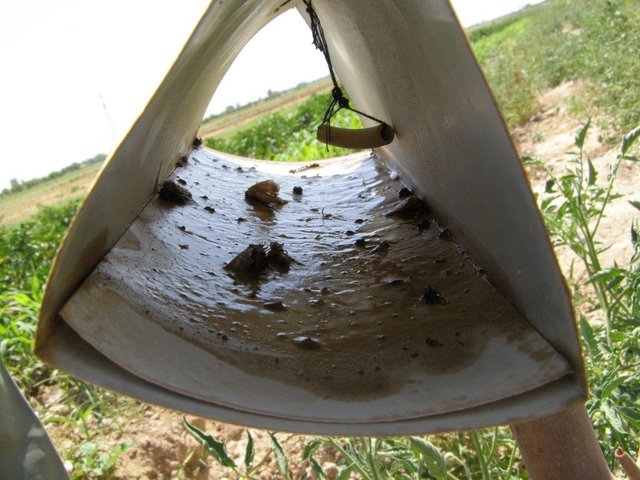
Pest management with pheromone insect traps [Tayikistán]
Coloured pheromone traps are set up in agricultural fields to attract and eradicate flying insect pests.
- Compilador: Firdavs Faizulloev
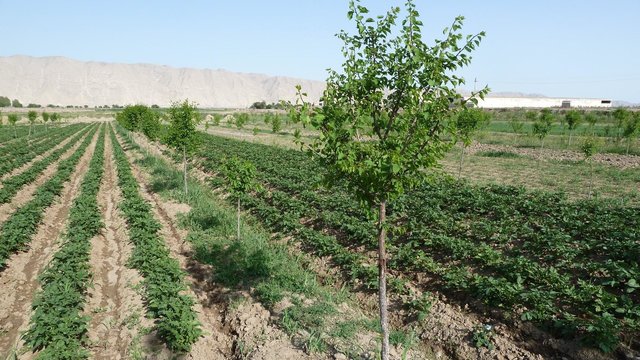
Rehabilitation of poor soils through agroforestry [Tayikistán]
An agroforestry system with peach, plum, sweet cherry and persimmon trees was established on a plot of land, with poor soil quality.
- Compilador: Natalia Mityakova
2. Descripción del Enfoque MST
2.1 Breve descripción del Enfoque
Farmer Field Schools (FFS) are held to fill farmer's gaps in knowledge on the use of sustainable agricultural technologies, efficient irrigation water use and prevention of land degradation using trials tailored to local conditions.
2.2 Descripción detallada del Enfoque MST
Descripción detallada del Enfoque MST:
Aims / objectives: Farmer field schools are part of the UNDP-GEF project on “Demonstrating Local Responses to Combating Land Degradation and Improving Sustainable Land Management in SW Tajikistan”. They were established with the aim to address the dissemination of sustainable agricultural technologies, and the introduction of new crops. Currently, many farmers in Tajikistan may not previously have been farmers during Soviet times and therefore may lack detailed agricultural knowledge and experience.
Methods: The FFS training is voluntary and the opportunities to attend are announced at Jamoat level. Each year 4 different groups, each comprising 10 to 20 farmers are formed in 4 different Jamoats. The learning comprises a range of activities from classroom teaching to hands-on field experience. The content of the training sessions are effectively adapted to the relevant season and crops as well as to the pests that may occur. The field school addresses some of the following topics; cultivation of winter wheat, potatoes, tomatoes and melons, adequate post harvest handling, use of trees and shelterbelts, generation of quality seeds, pest management, efficient use of irrigation water, etc. The field from which the FFS participants learn about agriculture in practice is a 0.5 ha plot provided by one of the farmers.
Stages of implementation: Before the start of the FFS, 4 local agronomists from target Jamoats were recruited by UNDP and sent on a study tour to Russia. These agronomists in their capacity as a Local FFS Consultant started running FFSs in each Jamoat. Initially, in conjunction with the National FFS Consultant of the SLM project, the local consultants organised several meetings with local farmers in order to identify their training needs. Taking into account the needs of farmers the curricula was prepared and the training schedule was agreed with the farmers/participants.
Role of stakeholders: The project engaged women who are generally considered landless and vulnerable. They were involved in the demo plots on the basis of agreement signed between a local women’s group and a farmer, who owned the land. According to this agreement 70% of the harvest is distributed among the women, and 30% remains for farmer. In addition, many training sessions on pest management, planting of tomatoes, potatoes etc were delivered to women at the demo plot. To ensure food security at the household level training on canning, preparation of juice and how to make jam were conducted. However, more male than female farmers participated in the FFS. This is linked to the fact that the role of male farmers on Dehkan farms is to take decisions on cropping patterns and instruct other farmers. Therefore better dissemination of knowledge is expected from male farmers participating.
Other important information: The project has been efficient in providing micro-loans through an agreement with the micro-loan organisation “Rushdi Obshoron” for agricultural purposes in all four Jamoats, In total, 100,000USD has been distributed to 4 Jamoats.
2.3 Fotos del Enfoque
2.5 País/ región/ lugares donde el Enfoque fue aplicado
País:
Tayikistán
Región/ Estado/ Provincia:
Khatlon
Especifique más el lugar :
Shaartuz
Map
×2.6 Fechas de inicio y conclusión del Enfoque
Indique año del inicio:
2007
Año de conclusión (si el Enfoque ya no se aplica):
2011
2.7 Tipo de Enfoque
- proyecto/ basado en un programa
2.8 Propósitos/ objetivos principales del Enfoque
The Approach focused mainly on other activities than SLM (agricultural production, market regulation, value chain development, seed multiplication )
The main aim of the approach is to support a change in mindset from a collective farming (Kolhoz) approach led by the state, onto private farmers putting more responsibility with the land users themselves. Since the collapse of the Soviet Union, many collective farms disintegrated and as a result of land reforms, the Dehkan farms came into being. People without an agricultural background could set up their own Dehkan farms and become farmers. However, a lack of knowledge and expertise frequently led to inappropriate land use which has contributed to land degradation. The objectives of FFS are to provide training sessions to farmers to improve their knowledge of better farming practices and the more rational use of land and water resources.
The SLM Approach addressed the following problems: lack of technical agricultural and ‘market economy’ knowledge, poverty
2.9 Condiciones que facilitan o impiden la implementación de la/s Tecnología/s aplicadas bajo el Enfoque
normas y valores sociales/ culturales/ religiosos
- impiden
Many women in the region do not own their own land and can therefore be very vulnerable
Treatment through the SLM Approach: They were involved in the FFS receiving special training on pest management, planting of tomatoes, potatoes, vegetable canning, preparation of juice etc. A benefit sharing agreement was signed between the women’s group and the farmer who owned the land
disponibilidad/ acceso a recursos y servicios financieros
- impiden
Lack of financial resources to buy fuel, fertilisers, livestock etc.
Treatment through the SLM Approach: A microloan organisation is providing credit loans from 2000-9000 Somoni (450-2,000 USD)
marco de trabajo legal (tenencia de tierra, derechos de uso de tierra y agua)
- impiden
The existing land ownership, land use rights / water rights moderately hindered the approach implementation Initially, farmers had no freedom to farm, meaning they were not allowed to choose which crops they would grow, however, after the economic crisis this changed.
conocimiento de MST, acceso a apoyo técnico
- impiden
In general farmer’s agricultural knowledge is weak. Especially as after the collapse of the Soviet Union anybody could get some land and become a farmer, even people who did not have a traditional farming background and therefore no agricultural knowledge
Treatment through the SLM Approach: In the field schools farmers are receiving training about new agricultural technologies and have the chance to get advice about their particular problems
otros
- impiden
No quality seeds were available
Treatment through the SLM Approach: UNDP provided seeds and ensured that a multiplication mechanism took place
3. Participación y roles de las partes interesadas involucradas
3.1 Partes interesadas involucradas en el Enfoque y sus roles
- usuarios locales de tierras/ comunidades locales
Local agronomists from Jamoat level were sent to Russia on a study trip to learn from Russian experiences with sustainable land management
Landless women, individual farmers
Only 1/3 of the participants were women. This is linked to the fact that the role of male farmers on Dehkan farms is to take decisions on cropping patterns and instruct other farmers. Therefore better dissemination of knowledge is expected from male farmers participating.
Landless women who are very vulnerable.
- especialistas MST/consejeros agrícolas
International specialists
National and local level consultants
- ONG
National agronomists working as consultants for UNDP
- organización internacional
UNDP
Si varias partes interesadas estuvieron involucradas, indique la agencia principal:
UNDP
3.2 Involucramiento de los usuarios locales de tierras/ comunidades locales en las distintas fases del Enfoque
| Involucramiento de los usuarios locales de tierras/ comunidades locales | Especifique quién se involucró y describa las actividades | |
|---|---|---|
| iniciación/ motivación | pasivo | |
| planificación | pasivo | |
| implementación | pasivo | Farmers only participated in FFS and were not involved in developing the content of training |
| monitoreo y evaluación | interactivo | No monitoring of the theoretical part of the approach took place, monitoring of land users success in applying the taught practices included interactive participation of land users. |
| Research | interactivo | Some research on crop performance was undertaken with interactive involvement of land users. |
3.3 Flujograma (si estuviera disponible)
Descripción:
Before the start of the FFS 4 local agronomists from target Jamoats were recruited by UNDP and sent on a study tour to Russia. These local FFS consultants then started running a FFS in each Jamoat.
Autor:
Julie Zähringer (Baumackerstr. 51, 8050 Zürich)
3.4 La toma de decisiones en la selección de Tecnología(s) MST
Especifique quién decidió la selección de las Tecnología/ Tecnologías a implementarse:
- principalmente por especialistas MST en consulta con usuarios de tierras
Explique:
Decisions on the method of implementing the SLM Technology were made by mainly by SLM specialists with consultation of land users
4. Apoyo técnico, fortalecimiento institucional y gestión del conocimiento
4.1 Construcción de capacidades / capacitación
¿Se proporcionó la capacitación a usuarios de tierras/ otras partes interesadas?
Sí
Especifique quién fue capacitado:
- usuarios de tierras
- personal de campo/ consejeros
Forma de capacitación:
- en el contexto de trabajo
- de agricultor a agricultor
- áreas de demostración
- cursos
Temas avanzados:
Sustainable irrigation water use, integrated crop management, tree planting for biodrainage, preventing gully formation, crop storage, effective seed production, pest management
4.2 Servicio de asesoría
¿Los usuarios de tierras tienen acceso a un servicio de asesoría?
Sí
Especifique si servicio proporcionado se realizó:
- en los campos de los usuarios de tierras
Describa/ comentarios:
Farmer Field Schools: Key elements: Classroom courses, Farmer to farmer visits, Demonstration plots; Research is done on demonstration plots. Farmer to farmer visits are needed for an exchange of experience between different farmers.
Advisory service is quite adequate to ensure the continuation of land conservation activities; As they were provided with adequate training, the local level consultants are now able to continue holding training in farmer field schools. If the provision of micro-loans and the pay-back scheme keep working, funding will be available to ensure continuation.
4.3 Fortalecimiento institucional (desarrollo institucional)
¿Se establecieron o fortalecieron instituciones mediante el Enfoque?
- sí, moderadamente
Especifique el nivel o los niveles en los que se fortalecieron o establecieron las instituciones:
- local
Especifique el tipo de apoyo:
- financiero
- construcción de capacidades/ entrenamiento
Proporcione detalles adicionales:
infrastructure, classrooms
4.4 Monitoreo y evaluación
¿El monitoreo y la evaluación forman parte del Enfoque?
Sí
Comentarios:
technical aspects were regular monitored by project staff through measurements; indicators: on farm productivity
bio-physical aspects were ad hoc monitored by land users through observations; indicators: market situation
economic / production aspects were regular monitored by project staff through observations; indicators: None
no. of land users involved aspects were regular monitored by project staff through measurements; indicators: None
There were no changes in the Approach as a result of monitoring and evaluation: None
There were several changes in the Technology as a result of monitoring and evaluation: Exchange of experiences between different Jamoats (Jamoats differed in types of crops cultivated).
4.5 Investigación
¿La investigación formó parte del Enfoque?
Sí
Especifique los temas:
- economía/ marketing
- ecología
- tecnología
Proporcione detalles adicionales e indique quién hizo la investigación:
Experiments about intercropping of different crop species. Local consultants also undertook research on marketing of different crops, which crop should be grown, and when for example, in order to achieve the best prices.
Research was carried out on-farm
5. Financiamiento y apoyo material externo
5.1 Presupuesto anual para el componente MST del Enfoque
Si no se conoce el presupuesto anual preciso, indique el rango:
- 100,000-1,000,000
Comentarios (ej. fuentes principales de financiamiento/ donantes principales):
Approach costs were met by the following donors: international (GEF / UNDP): 100.0%
5.2 Apoyo financiero/material proporcionado a los usuarios de tierras
¿Los usuarios de tierras recibieron financiamiento/ apoyo material para implementar la Tecnología/ Tecnologías? :
No
5.3 Subsidios para insumos específicos (incluyendo mano de obra)
- mano de obra
| En qué grado | Especifique los subsidios |
|---|---|
| totalmente financiado | Salary of consultants |
- equipo
| Especifique qué insumos se subsidiaron | En qué grado | Especifique los subsidios |
|---|---|---|
| maquinaria | not financed | |
- agrícola
| Especifique qué insumos se subsidiaron | En qué grado | Especifique los subsidios |
|---|---|---|
| semillas | totalmente financiado | |
- infraestructura
| Especifique qué insumos se subsidiaron | En qué grado | Especifique los subsidios |
|---|---|---|
| classrooms | totalmente financiado | |
- otro
| Otro (especifique) | En qué grado | Especifique los subsidios |
|---|---|---|
| Study trip for local consultants to Russia | totalmente financiado |
Si la mano de obra de usuarios de tierras fue un insumo sustancial, ¿fue:
- voluntario?
5.4 Crédito
¿Se proporcionó crédito bajo el Enfoque para actividades MST?
Sí
Especifique las condiciones (tasa de interés el apoyo, amortización, etc.):
Interest rate charged: 1.5%; repayment conditions: A microloan organisation was established and equiped by UNDP with a starting capital of USD 200,000. The interest rate is 1.5% per month, which is considered low compared to credits provided by other financial institutions. Moreover, it requires very limited papers to be provided for get a loan. Farmers pay back loans in cash. .
Interest was lower than market rate.
5.5 Otros incentivos o instrumentos
¿Se usaron otros incentivos o instrumentos para promover la implementación de Tecnologías MST?
No
6. Análisis de impacto y comentarios de conclusión
6.1 Impactos del Enfoque
¿El Enfoque ayudó a los usuarios de tierras a implementar y mantener Tecnologías MST?
- No
- Sí, un poco
- Sí, moderadamente
- Sí, mucho
More holistic thinking, including crop selection, cultural practices, conservation, integrated pest management etc. However, the number of farmers participating in field schools is still somewhat limited.
¿El Enfoque empoderó a grupos en desventaja social y económica?
- No
- Sí, un poco
- Sí, moderadamente
- Sí, mucho
Landless women were engaged in the field schools. The women groups kept 70% of the crop yield, while 30% was paid to the landowner of the demonstration plot. Food security increased for the women.
¿El Enfoque mejoró cuestiones de tenencia de tierra/ derechos de usuarios que obstaculizaron la implementación de la Tecnologías MST?
- No
- Sí, un poco
- Sí, moderadamente
- Sí, mucho
The approach could not reduce the problem, it was a governmental decision. The problem is likely to be overcome in the near future.
Did other land users / projects adopt the Approach?
- No
- Sí, un poco
- Sí, moderadamente
- Sí, mucho
The approach has not yet been disseminated over the country.
Did the Approach lead to improved livelihoods / human well-being?
- No
- Sí, un poco
- Sí, moderadamente
- Sí, mucho
higher crop yields
Did the Approach help to alleviate poverty?
- No
- Sí, un poco
- Sí, moderadamente
- Sí, mucho
Higher income through increased crop production.
6.2 Motivación principal del usuario de la tierra para implementar MST
- producción incrementada
- prestigio, presión social/ cohesión social
- agricultural knowledge
- well-being and livelihoods improvement
6.3 Sostenibilidad de las actividades del Enfoque
¿Pueden los usuarios de tierras sostener lo que se implementó mediante el Enfoque (sin apoyo externo)?
- sí
Si respondió que sí, describa cómo:
Farmers who were trained in the field schools are now able to disseminate their knowledge to other farmers. For this they receive some 'in kind' contribution from the farmers they teach such as seeds etc.
6.4 Fortalezas/ ventajas del Enfoque
| Fuerzas/ ventajas/ oportunidades desde la perspectiva del usuario de la tierra |
|---|
| Increased crop yields lead to increased family budget (How to sustain/ enhance this strength: Ensure application of taught practices.) |
| The farmers feel confident about what they do and are keen to disseminate their knowledge to other farmers (How to sustain/ enhance this strength: Dissemination of knowledge to other farmers so that more people can profit, for example through farmer to farmer visits) |
| The farmers know which crops to cultivate and how to adapt to the market conditions. |
| Integrated pest management helps to fight diseases and leads to better onion yield (How to sustain/ enhance this strength: Apply integrated pest management on all fields.) |
| Fuerzas/ ventajas/ oportunidades desde la perspectiva del compilador o de otra persona de referencia clave |
|---|
| The farmers are trained on the rational use of land and water resources which helps to reduce land degradation. (How to sustain/ enhance this strength: An emphasis has to be put on the prevention of land degradation.) |
| Farmers from different backgrounds enrich their farming practices and fill gaps in agricultural knowledge Topics taught in FFS should be diversified and continually updated. (How to sustain/ enhance this strength: Topics taught in FFS should be diversified and always be up to date.) |
6.5 Debilidades/ desventajas del Enfoque y formas de sobreponerse a ellos
| Debilidades/ desventajas/ riesgos desde la perspectiva del compilador o de otra persona de referencia clave | ¿Cómo sobreponerse a ellas? |
|---|---|
| Until now the FFS were running free of charge to the participants, however, this should be changed in order to raise more money to continue with the field schools, but farmers might not be willing to pay immediately, it takes some time before the farmers realise the significance of the FFS | Farmers would be more willing to pay if they were asked for in kind contributions, rather tha cash. |
7. Referencias y vínculos
7.1 Métodos/ fuentes de información
- visitas de campo, encuestas de campo
- entrevistas con usuarios de tierras
Vínculos y módulos
Expandir todo Colapsar todosVínculos

Pest management with pheromone insect traps [Tayikistán]
Coloured pheromone traps are set up in agricultural fields to attract and eradicate flying insect pests.
- Compilador: Firdavs Faizulloev

Rehabilitation of poor soils through agroforestry [Tayikistán]
An agroforestry system with peach, plum, sweet cherry and persimmon trees was established on a plot of land, with poor soil quality.
- Compilador: Natalia Mityakova
Módulos
No se hallaron módulos


